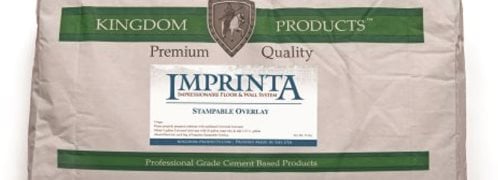- Concrete Overlays Home
- Get the Look - Interior Overlay Pictures
- When to Use a Polymer Overlay
- Comparison Chart of Overlay Systems: Which is best for your project?
- Five Factors to Consider when Choosing a Resurfacing System
- Concrete Overlay Reviews
- Types of Overlays
- Epoxy Coatings
- Microtoppings & Skim Coats
- Self-Leveling Overlays
- Spray-Down Toppings
- Polishable Overlays
- Stamped Concrete Overlays
- Preparing Concrete for Resurfacing
- Concrete Resurfacing
- Reducing Bond Failures Caused by Moisture-Vapor Transmission
- Don't Let Water Vapor Delaminate Your Overlay: How to seal concrete before an overlay
- How-To Tips for Installing Concrete Overlays
- Answers to Common Questions About Concrete Overlays: Advice from expert Chris Sullivan
- How to Add Color to Concrete Overlays
- How to Protect and Maintain Resurfaced Concrete
- Overlay Tools: Seven essential tools for concrete resurfacing
- Related Information
- Concrete Overlay Videos, with Bob Harris
- Decorative Concrete Overlays: A primer of the various overlay types and the decorative possibilities with each
- Vertical Concrete Overlays: Lightweight cement-based overlays mimic stone, brick, and other wall textures
Sealer and Maintenance Trends in Decorative Overlays
To improve the wear-resistance of overlays, contractors are shifting toward the use of higher-quality sealers and floor finishesThis is an excerpt from the new e-book “Concrete Overlays Today,” part of a series of reports from ConcreteNetwork.com on trends and insights about decorative concrete applications.
Free E-book:
Concrete Stamping Today
Discover seven rising trends in the overlay industry from ConcreteNetwork.com’s new e-book. You’ll get insights and advice from veteran overlay installers that will help you find success in today’s market.
Download Concrete Overlays Today (PDF)
If there is a hidden downside to the current trend toward the lighter colors and finishes popular in the decorative overlay industry, it has to be sealing and maintenance. Lighter colors tend to get dirty and show wear much faster than darker colors, which means the sealer and maintenance products need to meet a higher standard of durability. “Lighter colors demand more attention,” says Terry Grimble, director of technical services for Bomanite Company, who is seeing a trend toward the use of better-quality sealers.
Lighter colors and cleaner finishes also demand a higher caliber of sealer. Acrylics are no longer the go-to sealer for decorative concrete, and especially decorative overlays. High-solids polyurethanes, polyaspartics, and epoxies are now commonplace, especially in high-traffic and commercial applications. It is especially critical to have a high-solids sealer protecting thin-section overlays like microtoppings because the overlay will not withstand direct traffic long before beginning to wear. High-performance coatings may cost as much as three to five times more than acrylic sealers, but can last years longer.
One noticeable trend with sealers on decorative overlays has been the shift toward matte and satin finishes. About 20 years ago, a high-gloss finish was practically the only option available. For decades, the “wet look” was all anyone wanted. This trend held fast and was embraced by the decorative overlay industry through the mid-2000s. In the last few years, though, the trend has shifted away from gloss toward matte and satin finishes. The combination of lighter colors and simpler designs has also drawn more designers and installers to embrace matte sealers because they tend to hide scratches and wear better.
When it comes to sealer selection, Trevor Foster, western sales manager with Miracote Products, feels this is one area where contractors fall short. “People spend time and money focusing on the topping with little thought to the sealer,” he says. Foster believes strongly in educating installers and end-users on the importance of sealers and maintenance. Overlays are thin for the most part, which means the sealer is a critical part of the overlay flooring system as a whole. Foster also spends a lot of time educating the architectural and installer communities on the importance of using floor finishes over sealers on decorative overlays. He wants to start a new trend where we get away from using the term “wax” when describing these topcoat floor finishes. “The term wax conjures up images of cheap and unimportant. This is actually far from the truth. Wax does not do justice to what a floor finish does,” he says.
Floor finishes and maintenance schedules are important, yet they are often left out of the scope of work when installing decorative overlays. The good news is that educating installers seems to be paying off, as the decorative overlay industry has embraced better sealer systems, including the use of floor finishes.
Related information:
Protect and Maintain Resurfaced Concrete
Concrete Overlays
Return to Concrete Overlays Today
 Rapid Set Skim Coat
Repairs, levels, and smooths concrete for applications.
Rapid Set Skim Coat
Repairs, levels, and smooths concrete for applications.
 Thin Micro-Topping
Produces durable surface to color or stain
Thin Micro-Topping
Produces durable surface to color or stain
 Self Leveling Overlay
Find the overlay to meet your project's needs
Self Leveling Overlay
Find the overlay to meet your project's needs
 T1000 Stampable Overlay
For use with resurfacing concrete floors and hardscapes.
T1000 Stampable Overlay
For use with resurfacing concrete floors and hardscapes.
 Broom Overlay Mix 6000 PSI
Add water and mix - Grey or white
Broom Overlay Mix 6000 PSI
Add water and mix - Grey or white
 Flooring & Coating System
Epoxy Flooring System designed for concrete
Flooring & Coating System
Epoxy Flooring System designed for concrete
 Stamped Concrete Overlay
Warm weather and cold weather formulas
Stamped Concrete Overlay
Warm weather and cold weather formulas
 Imprinta Stampable Overlay
2-component system
Imprinta Stampable Overlay
2-component system





